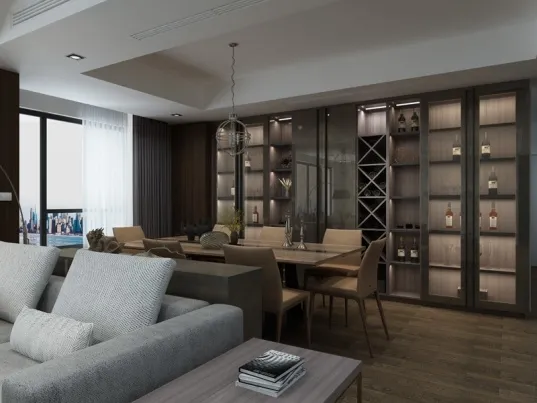
Budget Planning for Your Wine Cabinet Purchase

You know that feeling when you open a bottle you've been saving for a special occasion, only to discover it tastes... off? Maybe it's been stored too warm, or perhaps fluctuations in temperature robbed it of its magic. If this sounds familiar, it might be time to think about a dedicated wine cabinet.
But let's be real - these aren't impulse purchases. Between the initial cost and the ongoing electricity bill, a wine cabinet represents a meaningful investment in your wine journey. That's why smart budget planning isn't just practical; it's essential for making sure your collection gets the care it deserves without breaking the bank.
Getting Real About What You Really Need
The journey begins with a reality check. How much wine do you actually have? How much are you likely to collect? And here's the big one: are you buying mostly to drink soon, or are you building treasures for the future?
It's tempting to dream big. That oversized glass-front cabinet whispering promises of prestige? Gorgeous, yes. But if it's half-empty for years while you're paying to cool unused space, that premium glass front suddenly feels less impressive when the electricity bill arrives.
Crunching Capacity Numbers
Perfect if you're just starting out or prefer drinking over hoarding. These often fit under counters or in cozy corners. Look at 20-40 bottle cabinets.
You've caught the bug and need space to grow. Here's where 100-bottle units shine - they handle variety without swallowing your room.
Reserved for true oenophiles or those aging special vintages. At this point, you're not just buying storage - you're creating a showcase.
A golden rule? Think about where you'll be in five years, not just today. Buying slightly bigger than current needs means not needing an upgrade when you discover Barolo.
The True Cost of Going Cheap
We've all been there. You find what looks like a bargain - a cabinet priced at half what competitors charge. Celebration time? Not so fast.
Budget units often skimp where it matters:
| Feature | Premium Cabinet | Budget Risk |
|---|---|---|
| Temperature Stability | ±0.5°C fluctuations | ±3-5°C swings - the silent killer of fine wine |
| Humidity Control | Consistent 60-70% RH | Dries corks → oxidation |
| Vibration | Near-zero vibration compressors | Disrupts sediment → ruined mouthfeel |
| UV Protection | Triple-layer UV-resistant glass | Prematurely ages wine |
| Energy Efficiency | Energy Star rated | Eats power → costs more long-term |
Suddenly, that $500 savings looks questionable when your $3,000 Bordeaux collection starts tasting flat three years early.
Your Complete Budget Planning Checklist
Allocate 70% for cabinet purchase (including taxes/delivery), 30% for power consumption over 5 years. This reveals true costs.
Built-in models need pro installation. Freestanding units often require flooring reinforcement if heavy. Factor these in early.
App controls and remote sensors are convenient but add 15-30% to cost. Decide if you'll actually use them.
Essential if storing both reds and whites? Typically costs 20-40% more than single-zone. Maybe buy two smaller units instead?
Manufacturer-refurbished units often include full warranties at 30-50% discounts. Check Wine Guardian, EuroCave.
New releases come March-April. Last year's models get heavy discounts then. If timing works, patience pays.
Where Your Dollar Goes Furthest by Price Tier
Focus on thermoelectric models for quiet operation and decent efficiency. Expect basic temperature control without bells and whistles. Vinotemp VHSPV50I is a standout at this level.
The sweet spot. Compressor-based models appear, offering better temperature precision for aging wines. Dual zones become available. Look for Liebherr WKes 1661 or Perlick PC7000.
Professional-grade territory. Expect whisper-quiet operation, precision humidity control, and vibration dampening for long aging. EuroCave Premiere Series excels here.
Architectural statement pieces with museum-grade preservation. Think integrated security, dual compressors for fail-safes, and hyper-customization. Wine Guardian Ultimate range dominates.
The Operating Expense Reality Check
This catches many buyers off guard. That beautiful 300-bottle showcase? If it consumes energy like a thirsty teenager, you'll feel it every month.
Compare energy ratings religiously. An extra $200 upfront for an Energy Star model could save $1,000+ over ten years. Calculate using local kWh costs:
(Annual kWh usage × electricity cost/kWh) × 10 years
Pro tip: Place your cabinet away from heat sources like ovens or direct sunlight. This single decision can slash running costs by 20%.
The Warranty Wild Card
Consider this real story: A friend bought a discount cabinet. Compressor died at 13 months - conveniently one month after the warranty expired. Repair cost? 75% of the original price.
Premium manufacturers offer 5-10 year compressor warranties for a reason. That's peace of mind you can budget for. Ask yourself: "Would I save $300 now only to risk a $600 repair later?"
Final Word: Quality Over Quantity
In the wine cabinet world, this maxim rings truest. Sacrificing a few bottle spaces for superior technology means your wines will actually develop as intended. After all, what's the point of storing 120 bottles if half taste compromised?
Budget wisely, buy patiently, and you'll open bottles that remind you why you fell in love with wine in the first place. Now that's an investment that pays delicious dividends.
Tags:
Recommend Products











